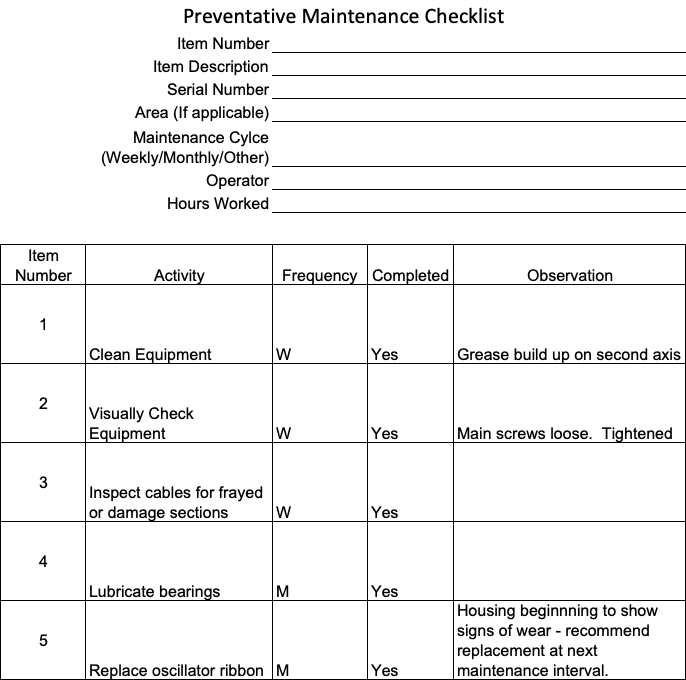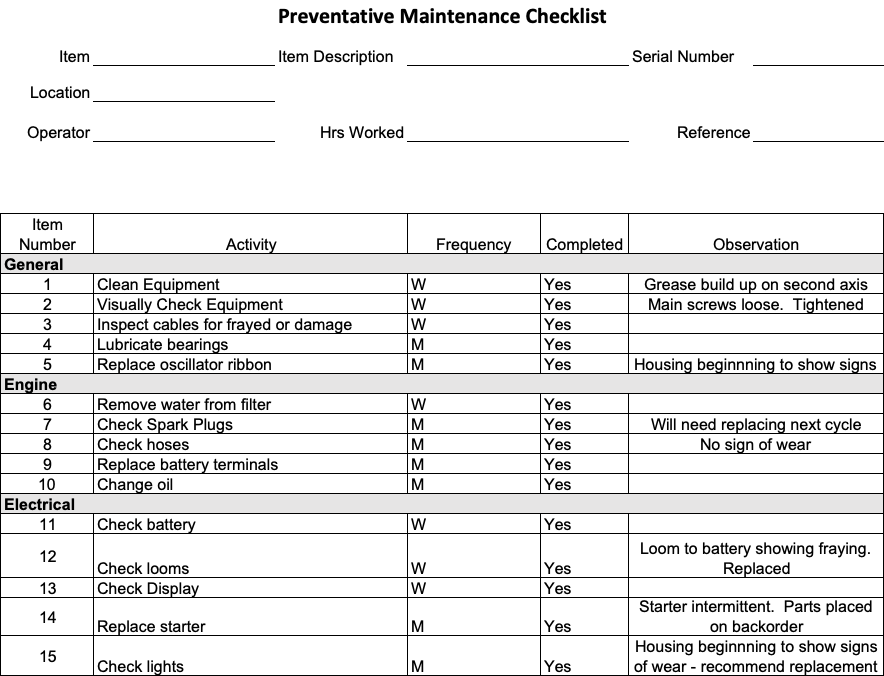A preventive maintenance checklist is a document that captures a collection of tasks that are expected to be undertaken to mitigate problems (such as machine breakdown) during normal operation.
Their use ensures the following of a prescribed process and that preventative maintenance tasks are executed as required. They also provide a mechanism for recording that activity has been carried out.
In this article, we’ll be looking at preventative maintenance checklists in detail, explaining their purpose, how you can create your own together with benefits you might expect through their use and potential issues you might come across.
We’ll be covering
- What is preventative maintenance
- 7 elements of preventative maintenance
- What is a preventative maintenance checklist?
- Maintenance checklist vs maintenance procedures?
- How do you use a preventative maintenance checklist?
- Example Preventative maintenance checklist
- Who uses a preventative maintenance checklist?
- Benefits of a preventative maintenance checklist
- Issues with Preventative maintenance checklists
What is preventative maintenance?
Machinery and equipment can fail. When it does, it can be costly, affecting production runs, capacity and, at its worst, impacting an organization’s ability to provide products to customers.
One way of reducing failure (and improving performance during standard operation) is to utilize preventative maintenance.
A simple analogy is that of a car service. You have your vehicle serviced in order to keep its performance optimal and avoid avoidable breakdowns. You might change your tyres, check your oil, and change filters. At the end of the process, you have an automobile that performs at an optimal level and is less likely to break down.
The same principles apply in industry. Preventative maintenance helps maintain infrastructure, work areas and equipment in order for standard processes to be effective. When considering the approach, there are many tools available to determine appropriate maintenance strategies, such as Resource Criticality Analysis, Risk Management, Reliability Centered Maintenance, Failure mode & Effects.
Preventative maintenance requires a formally recorded plan (which is established by the organization’s management) which determines what equipment is maintained and what maintenance steps are required.
Types of activity might include:
- Ensuring that machinery is clear of debris at the end of each shift
- That equipment is within expected specifications (i.e. tool sharpness)
- Worn or damaged parts have been replaced as required.
Clause 7.1.3 of 9001:2015 “requires the organization to plan, provide and manage its infrastructure effectively and efficiently. It should periodically assess the suitability of the infrastructure to meet organizational objectives.”
As a result, preventative maintenance is typically captured within an organization’s business management system and is a common process that is carried out.
7 elements of preventative maintenance
One method of capturing the rudiments of a robust preventative maintenance program is to consider the activities associated with 7 key elements of equipment maintenance which can be seen below:
1/ Installing
2/ Testing
3/ Servicing,
4/ Calibrating
5/ Inspecting,
6/ Adjusting
7/ Aligning
While there are variations on this concept, it’s a helpful reminder that there are various steps in a regular equipment routine where preventative maintenance can be applied.
The above list is not exhaustive, and when developing your preventative maintenance plan, you’ll need to consider the needs of your own business and any specific attributes pertaining to the type of equipment that you operate.
What is a preventative maintenance checklist?
A preventative maintenance checklist is a document (manual or electronic) that captures a set of tasks that an engineer or technical will undertake in order to complete a specific maintenance task.
A maintenance checklist ensures
- A standard process that can be applied to maintenance activity
- Clear instructions of what must be done are communicated to the maintenance engineer
- A form that can be validated in order to close down tasks
- A formal document that can be reviewed/updated in light of changing maintenance needs
Depending on how your organization manages their maintenance, checklists can be produced in-house through simple word processing or spreadsheets. They can also be produced via dedicated software that is used to coordinate maintenance activities.
They may also be produced in-house or by 3rd parties where they conduct preventative maintenance.
Driven by the complexity of the activity, the checklist may contain a small number of tasks or, in some cases, a large number of tasks that are grouped into sets of associated tasks. Whatever their complexity, the checklist is created by a specialist who has significant experience with the equipment being maintained.
A preventative maintenance checklist is usually not a static document but one that is maintained in light of manufacturer instructions regarding equipment. As a result, there is usually a need for a formal review (perhaps annual) of the document as part of your management system.
Maintenance checklist vs maintenance procedures?
Most organizations will have three sets of documents pertaining to preventative maintenance activity.
1/ Policy – Policies are documents that include information about a set of standards.
2/ Process – Describes how inputs are turned into outputs in order to comply with policies. They will describe responsibilities, referring policies, and record-keeping requirements.
3/ Plan – A plan describes the routine of what maintenance is carried out when
4/ Checklist – describes the detailed steps required to perform a process correctly.
Organizations may have many checklists, some processes and few policies.
How do you use a preventative maintenance checklist?
When it comes to using them, checklists are fairly simple.
They usually have several sections.
1/ Header
The header of the document captures
- Information pertaining to the activity, e.g. Maintenance reference number, date, hours associated (which could be predicted and actual)
- Information pertaining to the equipment being maintained, for example, Model name, number, serial number, location
- Information pertaining to the maintenance engineer – e.g. Name, Organization etc
- Summary of findings (ie. if the equipment was fit to use after the inspection
2/ Body
The body of the checklist usually contains
- A list of the maintenance tasks required
- Their status on conclusion of the task (i.e. ok, defective)
- Results of Specific measurements taken (i.e. fluid levels)
- Observations taken
- Follow-up actions required
Example Preventative maintenance checklist
Most checklists are variation on a standard theme.
Most use a header to capture information pertaining to the maintenance (i.e. what where, who) and a table that describes the detailed activities of the maintenance.
Most will also capture observations made by the individual carrying out the maintenance
Below is a simple example preventative maintenance checklist

It’s also possible to group activities within the checklist, as shown in the following example

Who uses a preventative maintenance checklist?
Administering preventative maintenance plans often depends on the size of the organization and/or the complexity of the equipment involved.
Smaller organizations will typically rely on in-house expertise to both evaluate and carry out maintenance. They may use standard tools to help prioritize equipment and record activity on spreadsheets or an in-house system.
Larger organizations or those with more complex needs may use external specialists to undertake some or all of the activity.
Benefits of a preventative maintenance checklist
As you can see from the above, there are numerous benefits to maintenance checklists; these include:
- They provide a standard way of executing preventative maintenance regardless of who carries it out.
- They ensure mandatory steps are captured and communicated to maintenance engineers.
- They provide a vehicle for an organization to review and assess the way in which maintenance is executed and therefore supports continuous improvement.
- They provide an evidence-based method that can form part of a process of ensuring preventative maintenance takes place.
Issues with Preventative maintenance checklists
As with any process, there are always some common pitfalls to watch out for; these include:
- Having a checklist is not the same as carrying out the work
- Not sustaining a review process and maintenance activity becoming misaligned with manufacturers’ recommendations
- Requires the engineer to use (and complete) the form
- Requires support by plans and policies in order to be fully effective
- Does not mitigate poor workmanship or lack of appropriate tools used during maintenance
Summary
The management of resources (such as machinery and other production equipment) is an important business process.
A failure to do this properly can lead to cost and production delays.
Utilizing a checklist provides a simple yet effective mechanism on how to conduct preventative maintenance.
While simple to produce, checklists can also be produced via appropriate software tools.
How have you implemented preventative maintenance in your organization? Do you use checklists or another means of executing the task?
If you have tips or learning that you would like to share, you can reach us on Twitter or via the comments section below.
